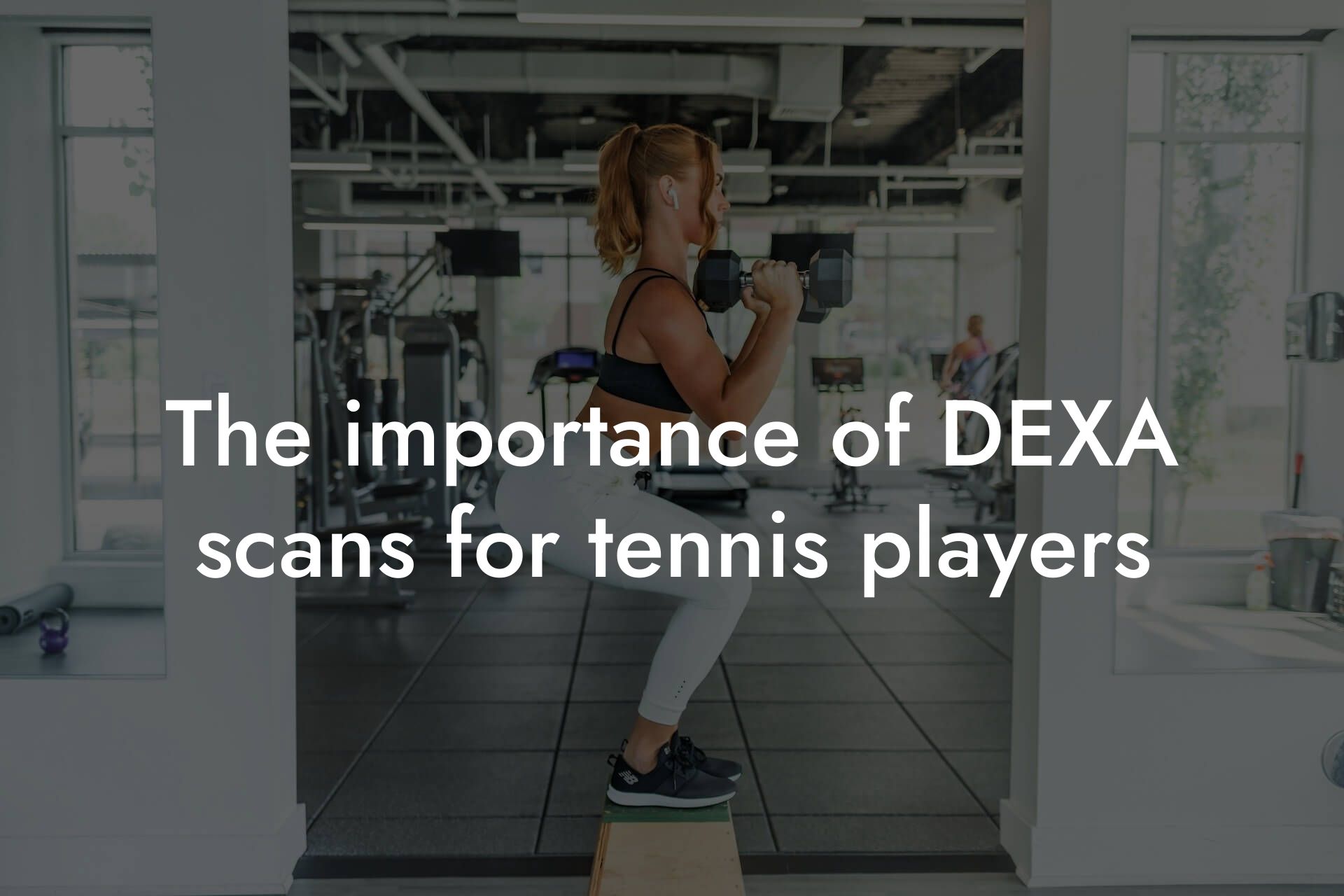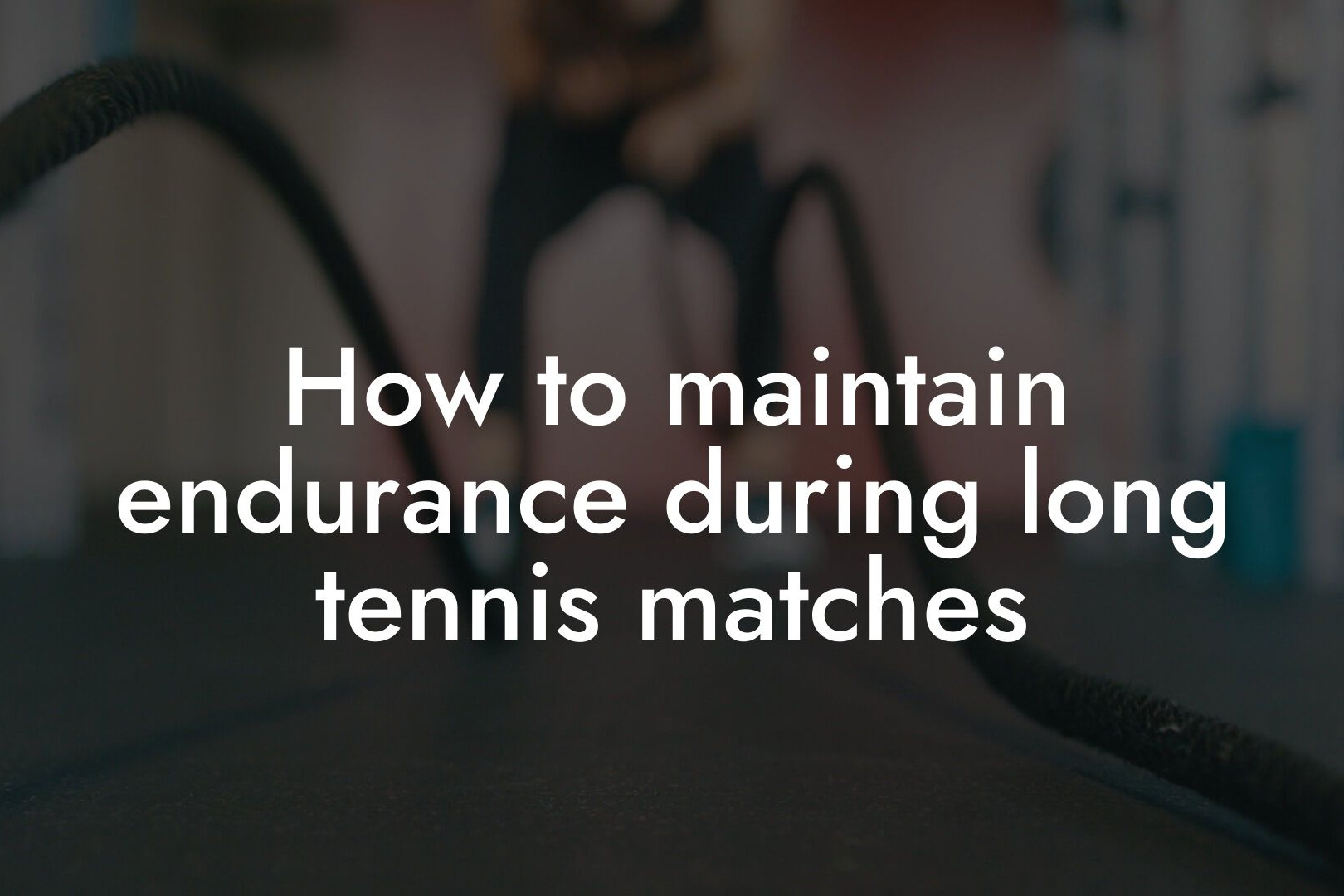As a tennis player, you know that the off-season is a critical period for improvement and preparation for the upcoming season. While it's tempting to take a break and relax, using this time to focus on conditioning can give you a significant edge over your competitors. In this article, we'll explore the importance of off-season conditioning for tennis players, and provide a comprehensive guide on how to structure your training to achieve optimal results.
Table of Contents
- Why Off-Season Conditioning is Crucial for Tennis Players
- Components of a Tennis-Specific Conditioning Program
- Periodization: A Key to Successful Off-Season Conditioning
- Sample Off-Season Conditioning Program for Tennis Players
- The Importance of Nutrition and Recovery in Off-Season Conditioning
- DEXA Scan: A Valuable Tool for Tennis Players
- Frequently Asked Questions
Why Off-Season Conditioning is Crucial for Tennis Players
Tennis is a highly demanding sport that requires a unique combination of strength, power, speed, agility, and endurance. During the competitive season, tennis players often focus on maintaining their current level of fitness, rather than making significant improvements. However, the off-season provides an opportunity to address weaknesses, improve overall fitness, and develop a strong foundation for the upcoming season. A well-structured off-season conditioning program can help tennis players:
- Enhance their overall fitness and athleticism
- Increase their strength, power, and speed
- Improve their agility and reaction time
- Enhance their endurance and stamina
- Reduce their risk of injury
- Gain a competitive edge over their opponents
Components of a Tennis-Specific Conditioning Program
A comprehensive off-season conditioning program for tennis players should include a combination of the following components:
- Strength Training: Focus on exercises that improve muscular strength, power, and endurance, such as squats, lunges, deadlifts, and bench press.
- Plyometric and Agility Training: Incorporate exercises that improve speed, agility, and reaction time, such as jump squats, box jumps, and shuttle runs.
- Endurance Training: Include aerobic exercises that improve cardiovascular fitness, such as running, cycling, or swimming.
- Flexibility and Mobility Training: Incorporate stretching and mobility exercises to improve range of motion and reduce the risk of injury.
- Power Training: Focus on exercises that improve explosive power, such as medicine ball throws and resistance band exercises.
- Functional Training: Incorporate exercises that mimic the movements and actions of tennis, such as lateral shuffles and carioca drills.
Periodization: A Key to Successful Off-Season Conditioning
Periodization is a training approach that involves dividing the off-season into specific phases, each with a unique focus and intensity. This approach allows tennis players to avoid plateaus, reduce the risk of overtraining, and ensure that they peak at the right time. A typical periodized off-season conditioning program for tennis players may include:
- Phase 1: Hypertrophy and Strength (4-6 weeks)
- Phase 2: Power and Speed (4-6 weeks)
- Phase 3: Endurance and Conditioning (4-6 weeks)
- Phase 4: Functional and Sport-Specific Training (4-6 weeks)
Sample Off-Season Conditioning Program for Tennis Players
Here's an example of a 16-week off-season conditioning program for tennis players, divided into four phases:
Phase 1: Hypertrophy and Strength (Weeks 1-4)
- Monday: Strength Training (legs and lower body)
- Tuesday: Endurance Training (30-45 minutes of cardio)
- Thursday: Strength Training (upper body and core)
- Friday: Flexibility and Mobility Training
Phase 2: Power and Speed (Weeks 5-8)
- Monday: Plyometric and Agility Training
- Tuesday: Endurance Training (30-45 minutes of cardio)
- Thursday: Power Training (medicine ball throws and resistance band exercises)
- Friday: Flexibility and Mobility Training
Phase 3: Endurance and Conditioning (Weeks 9-12)
- Monday: Endurance Training (45-60 minutes of cardio)
- Tuesday: Strength Training (legs and lower body)
- Thursday: Endurance Training (45-60 minutes of cardio)
- Friday: Flexibility and Mobility Training
Phase 4: Functional and Sport-Specific Training (Weeks 13-16)
- Monday: Functional Training (lateral shuffles and carioca drills)
- Tuesday: Endurance Training (30-45 minutes of cardio)
- Thursday: Sport-Specific Training (on-court drills and exercises)
- Friday: Flexibility and Mobility Training
The Importance of Nutrition and Recovery in Off-Season Conditioning
Nutrition and recovery play a critical role in supporting a tennis player's off-season conditioning program. A well-balanced diet that includes adequate protein, complex carbohydrates, and healthy fats can help support muscle growth and repair. Additionally, proper recovery techniques, such as foam rolling, stretching, and sleep, can help reduce muscle soreness and improve overall performance.
DEXA Scan: A Valuable Tool for Tennis Players
A DEXA (Dual-Energy X-ray Absorptiometry) scan is a valuable tool for tennis players, providing a comprehensive assessment of their body composition, including bone density, lean mass, and body fat percentage. This information can help tennis players identify areas for improvement, track their progress over time, and make informed decisions about their training and nutrition program.
Off-season conditioning is a critical component of a tennis player's annual training plan. By incorporating a well-structured conditioning program, tennis players can improve their overall fitness, enhance their performance, and gain a competitive edge over their opponents. Remember to periodize your training, focus on tennis-specific exercises, and prioritize nutrition and recovery to support your off-season conditioning program. With the right approach, you can take your game to the next level and achieve success on the court.
Frequently Asked Questions
What is off-season conditioning for tennis players?
Off-season conditioning for tennis players refers to the period of time when they are not actively competing in tournaments or matches, and focus on improving their overall fitness, strength, and endurance to prepare for the upcoming season. This is a critical phase in a tennis player's training cycle, as it sets the foundation for their success in the next season.
Why is off-season conditioning important for tennis players?
Off-season conditioning is essential for tennis players as it allows them to address any weaknesses or imbalances in their game, improve their overall fitness, and reduce the risk of injuries. A well-structured off-season program can help players gain a competitive edge, increase their confidence, and achieve their goals in the next season.
What are the key components of an off-season conditioning program for tennis players?
A comprehensive off-season conditioning program for tennis players should include a combination of strength training, plyometrics, agility drills, cardiovascular exercise, and flexibility exercises. Additionally, players should also focus on nutrition, recovery, and mental preparation to ensure they are fully prepared for the demands of the upcoming season.
How long should an off-season conditioning program last?
The duration of an off-season conditioning program can vary depending on the player's goals, current fitness level, and the time of year. Generally, a well-structured program can last anywhere from 8-16 weeks, with a gradual increase in intensity and volume over time.
What are the benefits of strength training for tennis players?
Strength training is essential for tennis players as it helps improve their power, speed, agility, and endurance. A well-designed strength training program can also reduce the risk of injuries, improve joint stability, and enhance overall athletic performance.
What types of strength exercises are best for tennis players?
Tennis players should focus on exercises that improve their functional strength, such as squats, lunges, deadlifts, and step-ups. Additionally, exercises that target the core, glutes, and legs are also essential for generating power and speed on the court.
How can tennis players improve their agility and speed?
Tennis players can improve their agility and speed through a combination of plyometric exercises, agility drills, and resistance band training. These types of exercises help improve their reaction time, acceleration, and deceleration, allowing them to cover the court more efficiently.
What is the importance of cardiovascular exercise for tennis players?
Cardiovascular exercise is critical for tennis players as it helps improve their endurance, increase their stamina, and enhance their overall fitness. A well-structured cardiovascular program can also help players recover faster between points and matches.
What types of cardiovascular exercises are best for tennis players?
Tennis players should focus on high-intensity interval training (HIIT) exercises, such as sprints, pro shuttle runs, and court-specific drills. These types of exercises help improve their anaerobic endurance, speed, and agility, allowing them to perform at a high level during matches.
How can tennis players improve their flexibility and mobility?
Tennis players can improve their flexibility and mobility through a combination of static stretches, dynamic stretches, and foam rolling exercises. These types of exercises help improve their range of motion, reduce muscle tension, and enhance their overall athletic performance.
What is the importance of nutrition for tennis players during the off-season?
Nutrition plays a critical role in a tennis player's off-season conditioning program. A well-balanced diet that includes adequate protein, complex carbohydrates, and healthy fats helps support muscle growth, recovery, and overall athletic performance.
What types of foods should tennis players focus on during the off-season?
Tennis players should focus on whole, unprocessed foods such as lean proteins, complex carbohydrates, fruits, vegetables, and healthy fats. Additionally, players should also stay hydrated by drinking plenty of water and limiting their intake of sugary drinks and processed snacks.
How can tennis players optimize their recovery during the off-season?
Tennis players can optimize their recovery during the off-season by getting adequate sleep, stretching and foam rolling regularly, and using recovery tools such as compression garments and cryotherapy. Additionally, players should also prioritize rest and relaxation to allow their bodies to fully recover.
What is the importance of mental preparation for tennis players during the off-season?
Mental preparation is critical for tennis players during the off-season as it helps them stay focused, motivated, and confident. A well-structured mental training program can also help players develop a winning mindset, overcome fears and doubts, and perform at a high level under pressure.
What types of mental training exercises are best for tennis players?
Tennis players can benefit from a variety of mental training exercises, including visualization, positive self-talk, and mindfulness meditation. These types of exercises help players develop a strong mindset, overcome adversity, and perform at a high level under pressure.
How can tennis players stay motivated during the off-season?
Tennis players can stay motivated during the off-season by setting clear goals, tracking their progress, and celebrating their successes. Additionally, players should also surround themselves with a supportive team, including coaches, trainers, and family members, to help them stay focused and motivated.
What are the common mistakes tennis players make during the off-season?
Common mistakes tennis players make during the off-season include not having a clear training plan, not prioritizing recovery, and not focusing on their weaknesses. Additionally, players may also make the mistake of not seeking guidance from a qualified coach or trainer, which can hinder their progress and increase their risk of injury.
How can tennis players get the most out of their off-season conditioning program?
Tennis players can get the most out of their off-season conditioning program by setting clear goals, staying consistent, and tracking their progress. Additionally, players should also be patient, stay committed, and trust the process, as a well-structured off-season program takes time to yield results.
What are the benefits of working with a coach or trainer during the off-season?
Working with a coach or trainer during the off-season can help tennis players develop a customized training program, stay accountable, and receive guidance and support. Additionally, a qualified coach or trainer can also help players identify their weaknesses, improve their technique, and develop a winning mindset.
How can tennis players incorporate technology into their off-season conditioning program?
Tennis players can incorporate technology into their off-season conditioning program by using wearable devices, mobile apps, and video analysis tools. These types of technologies can help players track their progress, monitor their recovery, and improve their technique, allowing them to optimize their training and gain a competitive edge.
What are the key takeaways for tennis players during the off-season?
The key takeaways for tennis players during the off-season are to stay focused, stay committed, and trust the process. A well-structured off-season conditioning program can help players improve their overall fitness, reduce their risk of injury, and gain a competitive edge, allowing them to achieve their goals and reach their full potential.
Here are some related articles you might love...
- Strength training programs for tennis athletes
- The importance of DEXA scans for tennis players
- How to maintain endurance during long tennis matches
- The role of bone density in preventing tennis injuries
- Improving core strength for better tennis strokes
- How body composition impacts tennis agility and speed
- Nutrition strategies for sustained energy during tennis matches
- Reducing body fat to enhance tennis performance
- Recovery techniques for tennis professionals
Zak Faulkner
Zak Faulkner is a leading authority in the realm of physical health and body composition analysis, with over 15 years of experience helping professionals optimise their fitness and well-being. As one the experts behind Tano Performance Group, Zak has dedicated his career to providing in-depth, science-backed insights that empower clients to elevate their physical performance and overall health.
With extensive knowledge of DEXA technology, Zak specializes in delivering comprehensive body assessments that offer precise data on body fat, muscle mass, bone density, and overall physique. His expertise enables individuals to make informed decisions and achieve their fitness goals with accuracy and confidence. Zak’s approach is rooted in a deep understanding of human physiology, combined with a passion for helping clients unlock their full potential through personalised strategies.
Over the years, Zak has earned a reputation for his commitment to excellence, precision, and client-focused service. His guidance is trusted by top professionals who demand the best when it comes to their health. Whether advising on fitness programs, nutritional strategies, or long-term wellness plans, Zak Faulkner’s insights are a valuable resource for anyone serious about taking their health and fitness to the next level.
At Tano Performance Group, Zak continues to lead our Content Team revolutionising how professionals approach their physical health, offering unparalleled expertise that drives real results.




